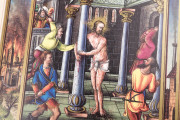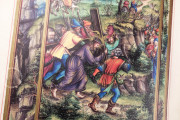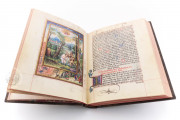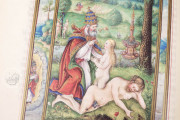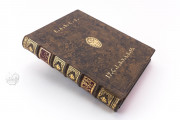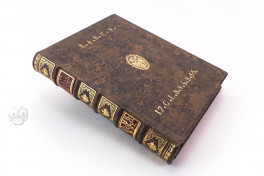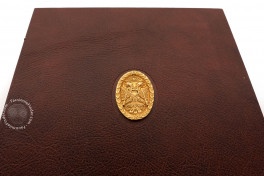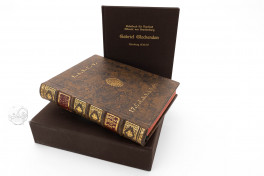The Vienna Prayer Book of Albrecht of Brandenburg, created between 1536 and 1537 in Nuremberg, is a Christian devotional manuscript featuring text elegantly written by Georg Stierlein and full-page miniatures by Gabriel Glockendon. The manuscript's full-page miniatures of scenes from the life of Christ are richly supplemented by scenes from the Old Testament in the borders. The paintings are characterized by intricate details of clothing, architecture, and landscapes. The book was created for Cardinal Albrecht of Brandenburg, Archbishop and Elector of Mainz, a conspicuous patron of the arts.
The Viennese manuscript, comprised of 100 leaves on parchment, was illustrated by Gabriel Glockendon with 42 full-page miniatures.
An incredible text
After a “prologue” with the creation of Eve, the book presents the history of salvation from the annunciation to the entombment of Christ, accompanied by typological suitable scenes from the Old Testament in the background. Five devotional miniatures invite meditation over the suffering of Christ.
Georg Stierlein who worked for Cardinal Albrecht von Brandenburg in Halle has written the text and decorated it with borders and 73 ornamental initials.
Nuremberg and Halle are the places of origin of the Codex, which was completed on 25.9.1537, according to an inserted note.
References of the past
The text and miniature program are identical to two older manuscripts, the first completed by Simon Bening about 1525/50, and the second by Nikolaus Glockendon in 1533/34, both also commissioned by Cardinal Albrecht. The common basis for all three works, could be traced to a German prayer book printed in 1521 in Augsburg wich contains a translation of the “Orationes et meditationes de vita Christi” of Thomas von Kempen.
Cardinal Albrecht, who must have admired the text beyond all measures, had, thanks to Gabriel Glockendon’s illustration, a fascinating new collection of unique miniature paintings for private devotion.
A very peculiar style
Gabriel Glockendon was the son of the famous Nikolaus Glockendon. Only a few documents reveal information about his life. Gabriel Glockendon’s authorship of the Codex 1847 in the Austrian National Library is proven by the monogram GG = Gabriel Glockendon.
Dagmar Thoss characterizes Gabriel, who probably took over his father’s workshop sometime after his death, as follows: "The prayer book in Modena was the last work of Nikolaus Glockendon; he must have died immediately after completion of the work."
The younger Gabriel Glockendon already represented a more modern, quite mannerist style. According to Thoss, there is a trend towards more detailed decoration of the architecture and the garments as well as in open spaces in landscape scenery. The coloring is also typical. The dominant components of the coloring are extremely strong colors which are thinned out to the extent that they look iridescent. Hence, the lively, very differentiated character of the overall impression of the illustrations.
Thus, we owe Albrecht von Brandenburg, one of the mightiest Church Princes during the period of the Reformation, this precious prayer book symbolically seen as one of the last expressions of the brilliance of manuscript illumination.
We have 3 facsimiles of the manuscript "Vienna Prayer Book of Albrecht of Brandenburg":
- Gabriel Glockendon: Gebetbuch für Kardinal Albrecht von Brandenburg (Standard Edition) facsimile edition published by Bibliotheca Rara, 2008
- Gabriel Glockendon: Gebetbuch für Kardinal Albrecht von Brandenburg (Deluxe Edition) facsimile edition published by Bibliotheca Rara, 2008
- Gabriel Glockendon: Gebetbuch für Kardinal Albrecht von Brandenburg facsimile edition published by Wissen Media Verlag GmbH, 2008






